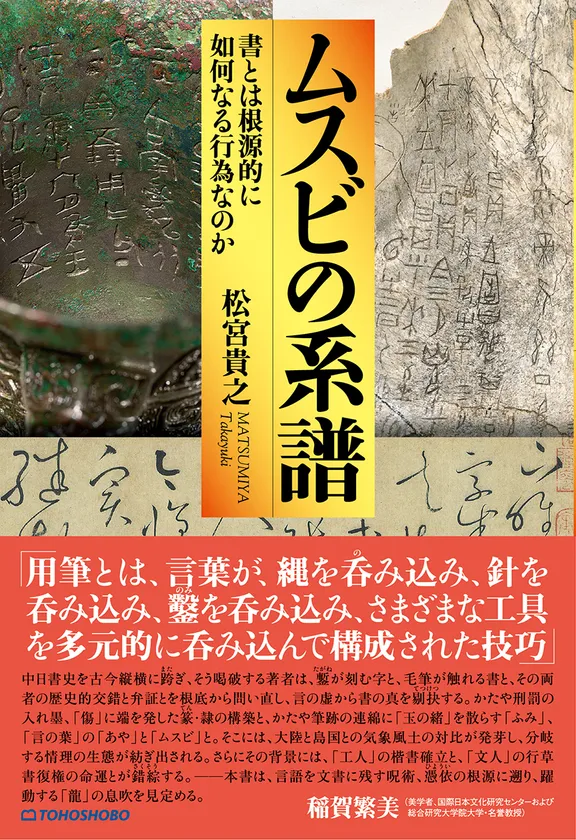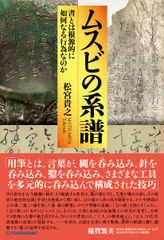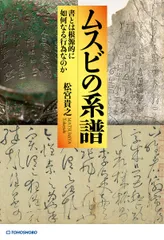What is a book?" A New Book Tackles This Fundamental Question Head-on The Genealogy of Musubi: What is the Fundamental Act of Calligraphy? will be released on October 15, 2025.
株式会社東峰書房
Toho Shobo Co. (Head office: Shinjuku-ku, Tokyo; Representative Director: Kei Kagamibuchi) will release a new book by a calligrapher on the origins of calligraphy, "Musubi no Keifu: What is calligraphy fundamentally an act?

Book shadow (1)
Book introduction site
https://tohoshobo.info/?p=2081
Calligraphy, now called "shoho" in China, "shogi" in Korea, and "shodo" in Japan, is a culture that has taken root in East Asia.
The power to connect is also the power to give birth---the word "musubi" is a combination of the two words musu = birth and hi = spirit, and refers to the power at the moment something is born, as well as the ability to connect people to people, and people to the other world (ancestors) and this world, or the "connecting" function.
This book attempts to deconstruct the myths surrounding the origin of writing and to restore the primitive form of calligraphy by tracing "musubi" back to the age of yunawa (rope tying) and shoki (calligraphy and calligraphy notes). Based on an examination of the customary and religious meanings of the brush and an investigation into the meanings of ink and water as a means of analogical incantation, we will reconstruct the process that led to the birth of calligraphy as a literature, and capture the continuity and transformative nature of the theory of calligraphy.
In addition, the sensitivity of the Japanese language is revealed and the characteristics of Japanese calligraphy are discussed. In summing up, he summarizes the history of calligraphy in terms of "literary" and "craftsmanship," and uses dialectics to provide a panoramic view of the entire history of calligraphy.
This book approaches the "root of calligraphy," and presents a theory that will rewrite the established theories.
Outline of "The Genealogy of Musubi: What is the Fundamental Act of Calligraphy?
Format: 46 pages
Number of pages: 208
Price: 2,750 yen (including tax), 2,500 yen + tax
Author :Takayuki Matsumiya
Table of Contents
Introduction: The Landscape of Yunawa and Shokei: A Challenge to Deconstruct the Myth
What is calligraphy?
The Identity of the Yunawa and the Calligraphic Qiye / The Essence of the Yunawa and the Calligraphic Qiye
Chapter 1 In Search of the Origin of Calligraphy
The Essence of Calligraphy / The Thread Bundle and the Yunawa Rope / From Writing to Twill / From Scratches to Threads, and then to the Knot of the Brush / The Essence of Calligraphy
Theory of "Bushi" / Around "Usu" and "Fumi" / To let go and to write / To possess and to exorcise /
The boundary between ink and rope (woolen bundle): the sacred and the profane / The history of Qi-goku and the history of woodblock engraving: a theory of non-draftsmanship / The history of history and craftsmanship: a theory of the speaker and the craftsman
History and craftsmanship: the speaker (brush and history) and the writer (craftsmanship)
Original Theory of Calligraphy / The Truth of the Sokkei Scripts: Bone Scripts Connecting Brush and Rope / Tattoos and Jomon Style / The Rope Scripts of the Jomon Period
Tattoos and the Jomon style / Rope and Snake: The Hundred Families of the Writer and the Calligrapher
Chapter 2 The Significance of the Brush and Ink
The elements that make up calligraphy / The origin of the brush and the theory of ropes / Shijing, the theory of nawa-rope / A memento, revival, and sumi ink / The hidden disappearance and the origin of the calligrapher / The origin of the calligrapher
The origin of the hidden disappearance and the calligrapher / The analogy between ink and rain / The verification of the spell and the bone script / The sacrifice of burning, ink, and water / The theory of the hikon / The spell and the rope / The theory of the hikon / The theory of the hikon and the rope
The theory of hiko / Spells and the rope-user / The theory of the touch of the rope / The culture of thread and literature
Chapter 3: The Epicenter of Calligraphy and Writing
The Epicenter of Antiquity: The Three Great Breaths of Chinese Civilization / Civilization and Writing: The Crystallization Point of the Warring States Period
Theory of deciphering carved stones: Unification of calligraphy and script / The first emperor's summary of the writing of the sermon and the writing of the decipherment of script / The revolution of Xu Xin
Xu Xin's Revolution / The Concept of Calligraphy in Motion / Cursive Writing and Letters / The Transformation from Intelligence to Feelings
The Emergence of the Actor / The Story of the Writing of Writings and Craftsmanship: A Theory of Calligraphy / The Cognitive Method of Calligraphy / The Truth of Nature and Ingenuity
The Truth of Nature and Ingenuity / Wang Xizhi and the Dragon / A Historical Interpretation of the Dragon's Calligraphy
The theory of the "Xuan Sen" (line) of thread and ink: spiritualization and the formation of a colorful environment.
Chapter 4: The Sensibility and Basis of Japanese Calligraphic Culture
The Origin and Idea of the Culture of Saikai-bathing / Conditions and Objects of Yoriyo / The Shimenawa Theory / Gods and Paper / The Kojiki / Shime-nawa and Yubiki / The Shime-nawa and Yubiki
Kojiki / Shime-nawa and the boundary / The Land of Threads / Manyoshu, Knots, and Kino / Margins, Space, and Air
The base of the sensibility of poverty / Windless and stormy winds / Isolated island of Fumi
Chapter 5 Literature and Craft
Culture of Scratches and Stones / Tattoos of the Heart and Chinese Characters / Sumiko's Religious Theory / Blood Covenant and Blood Scripts
Words, Scripts and Historical Layers / Scripts and Meanings / Wang Xizhi's Slip and Tablet / The Appearance of Words and Deeds
Threads, chi, and literati context: Discovering the breath of the pull and pressure / The landscape of calligraphy and storytelling / The landscape of calligraphy and storytelling / The landscape of calligraphy and storytelling
Attribution and punishment / Ideas that compose awards / The historical interaction and dialectics of craftsmen and literati
Afterword
List of Sources and Holdings of Illustrations
Author's Profile
Author: Takayuki Matsumiya
Writer and calligrapher.
Born in 1971.
Graduated from Tokyo Gakugei University, Faculty of Education, Art Course, Calligraphy Department.
M.A. in Literature (Nishimatsu Gakusya University)
Master of Education (Tokyo Gakugei University)
Doctor of Science (The Graduate University for Advanced Studies)
Part-time lecturer at Osaka University,
Part-time lecturer at Osaka University, Bukkyo University and Shikoku University Graduate School
[Main publications]
Calligraphy and Contemplation (Toho Shoten, 2019), Tattoo and Kanji (Yuzankaku, 2021), The Calligrapher Kaku Moruo (Musashino Shoin, 2024), A New Cultural History of Calligraphy (Yuzankaku, 2024), Politicians and Calligraphy: Japanese Culture in Modern Times, Second Edition (Yuzankaku, 2025)
[Major publications.]
A Historical Study of Xu Wei's Shanzha Poems in the Tokyo National Museum's Collection of "Hua Shu Zhuangga Scrolls": Representations of Painting and Calligraphy, and the Meanings of 'Resignation' and 'Hatred'", MUSEUM (Tokyo National Museum Research Journal) No. 702, "Dong Qichang's Zen and the Structure of Song-Ming Rigaku" (Bulletin of the Institute for Zen Studies) No. 37, pp. 399-300.
Recommendations
In his "History of Chinese Calligraphy" and other works, Ishikawa Kuyo postulated "brush erosion" as the root of "brush touch. This hypothesis assumed the stage of engraving characters on gold stones with chisels and chisels before the age of the brush on paper. In this book, however, Takayuki Matsumiya proposes a radical reconsideration. He has explored the background of Xu Xin's "The Analects of Wang Xizhi" in light of the development of research on Shang dynasty bone script, and has examined the process that led to the deification of Wang Xizhi. If we assume the origin of the script in the activity of twisting threads and tying ropes, and if we assume writing on bamboo and wood strips, we can see the source of the calligraphy Qi in the tying ropes. Behind the establishment of the seal script and the slang script, Sumiko's discourses on the execution of punishment emerge. Ink is a tattoo, and soot is derived from bone ash. If stone monuments were an administrative requirement, stone carving should have been left to the hands of artisans. In contrast to the generalization of the standard style of calligraphy due to the establishment of a bureaucratic society, the use of line writing was restored as a means of expressing the personal feelings of the literati, and the calligraphy of Wang Xizhi was evaluated. In contrast, Japanese calligraphy deviated from the standard style to a series of scattered strokes with the establishment of hiragana, and the world of waka poetry dismantled the Chinese character civilization. On the tanzaku, a strip of paper used as a yorishiro (a place of refuge) for the sacred rope of shimenawa (sacred rope) and snake worship, leaves of speech, which are not "letters," drip down as water stalks. After all, calligraphy is a "dragon" that flies by touch. The study of the Changsha brush strokes of the Chuxia dynasty, and the investigation of numerous references to Chinese classics and Japanese poetry, lead us to question the development of "calligraphy" as a "rope" dating back to Fushiki-Jioka.
Shigemi Inaga (Aesthetist, Professor Emeritus, International Research Center for Japanese Studies and The Graduate University for Advanced Studies)
Published by: Toho Shobo Co.
(1) Company name: TOHOSHOBO Corporation (https://tohoshobo.info/)
English name: TOHOSHOBO INC.
(2) Representative: Takashi Kagamibuchi, Representative Director
(3) Head office: 4-2-20 Shinjuku, Shinjuku-ku, Tokyo
(4)Main business: Publishing of business books
(5)Capital :35 million yen
- Category:
- Goods


